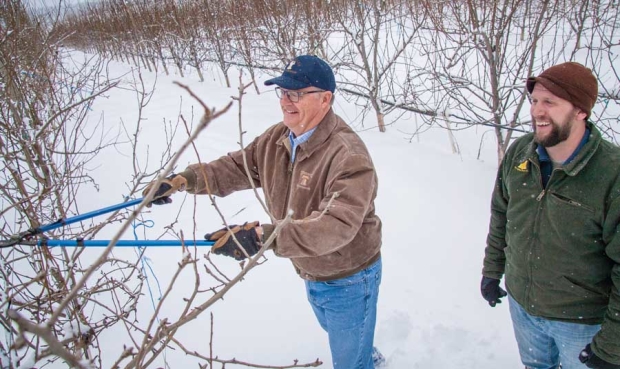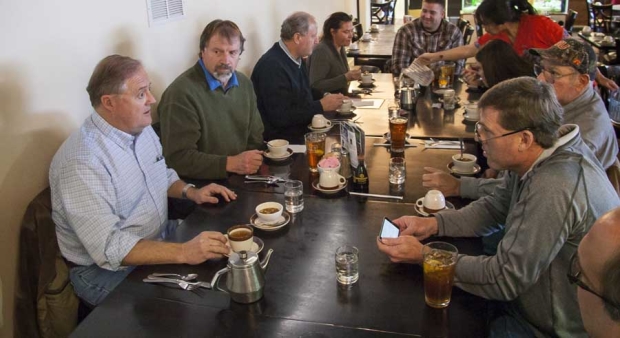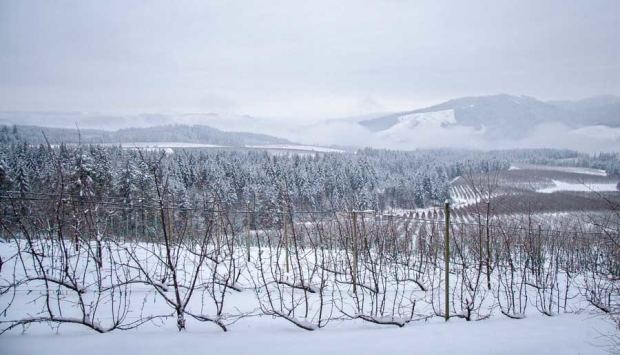
Don Gibson, left, president of the Mt. Adams Orchard Corp., evaluates pear trellises with Tim Pitz, assistant superintendent, on Jan. 5, 2016, at the company’s orchards in White Salmon. Gibson makes it a point to visit employees, orchards and facilities in person during his weekly trips. (Ross Courtney/Good Fruit Grower)
Driving west on State Route 14 through wild arid bluffs overlooking the Columbia River, Don Gibson couldn’t resist the irony.
“Where in the Sam Hill are we?” he said, cracking wise in reference to the nearby Maryhill Museum, founded by land-company owner Samuel Hill, one of several possible sources of the common American idiom.
Truth be told though, the president of Mt. Adams Orchards Corp. knows exactly where he is — inside the mobile office that is his Jeep Grand Cherokee Overland.
To stay connected to the vertically integrated fruit company he leads and its 345 full-time employees, the 2015 Silver Pear Award winner drives a weekly route from his Yakima, Washington, administrative office to orchards and packing houses through the Columbia Gorge and back, a round trip of 300-plus miles.
He simply prefers face-to-face interaction. “It’s a people business,” Gibson said.
The Washington State Tree Fruit Association honored Gibson, the 57-year-old married father of two, with the Silver Pear Award during its annual conference in December in Yakima.
The former banker was lauded for keeping a close eye on the bottom line and getting involved with all facets of the industry, which includes serving on the science committee of the Northwest Horticultural Council and Pear Bureau Northwest’s board of directors.
“Don is an outspoken and detailed-oriented board member, which is a good thing, and he has the industry’s best interests in mind,” said Kevin Moffitt, president of Pear Bureau Northwest.
Gibson quickly credits his colleagues. “It’s a team approach,” he said.
That’s why he considers his weekly trip through parts of Washington and Oregon — with stops in Alderdale, Dallesport, Hood River, White Salmon and Bingen — worth every mile.
Joining the fruit industry
Gibson grew up as the youngest of six siblings on a row crop farm near Connell, Washington, and holds bachelor’s degrees in finance and economics from Central Washington University.
He started his career in banking, officiating a loan for Jack Bloxom, the former president of Mt. Adams, in a 1983 orchard investment.
Gibson disliked the smoke-filled boardrooms and lack of autonomy in the banking world, so he switched to work as a field representative for brewing giant Anheuser-Busch Companies.
In 1993, he nearly took an executive’s position in St. Louis when Bloxom called to offer him an assistant manager’s spot at Mt. Adams.
“I liked his style,” said Bloxom, now the semi-retired chairman of the company’s board of directors. He communicates well with employees, growers and customers, Bloxom said.
Gibson has been company president since 2008.
As a former banker, Gibson understands the importance of the bottom line. To keep the company “sales-driven,” he spends most of his week in the administrative offices, co-located with Washington Fruit and Produce Co. in Yakima.
Underwood Fruit and Warehouse Co., the packing entity under the Mt. Adams ownership group, pays a commission to Washington Fruit to sell produce packed in Bingen and Dallesport.
The two companies also have a history of common ownership in the past, though are wholly independent now.
Gibson didn’t initiate the weekly road trips; they are a part of the company’s culture.
Bloxom drove the same route himself 40 to 50 times a year for 30 years during various management stints and as the company president. He still makes the trip himself once every month or so.
“You can be told anything, but it’s good to see it, too,” Bloxom said.
The staff in the Gorge appreciates Gibson’s visits, said Brad Pickering, assistant superintendent of the company’s pear and apple packing facilities in Bingen.
“Having him here to see the challenges of a piece of equipment we have … or staffing, it just makes it easier,” he said.
Employees, some of whom represent the third generation with the company, smile and say hello during his plant tours in Bingen.
One woman even offered to let him take over after he inspected a pear in her packing tub. He smiled and said, “No thanks.”

Don Gibson, left, president of the Mt. Adams Orchard Corp., shares market information with pear grower Ken Goe over lunch at a Chinese restaurant in Hood River, Oregon. (Ross Courtney/Good Fruit Grower)
Taking growers out to lunch is part of his routine, too. About 40 percent of the company’s pears come through custom pack contracts with outside growers.
While waiting to order at the China Gorge Restaurant in Hood River, Gibson showed grower Ken Goe some pear market information on his smart phone and discussed the possibility of setting up an H-2A training session for other Hood River-area growers.
For his part, Gibson also likes the trips. “I do enjoy this,” he said. “This is the good part of the job.” But there are plenty of unpleasant parts.
He had to lay off people in 2012 to keep the company’s pear canning facility solvent enough to attract a buyer — Seneca Foods Corp. — in 2013.
The company opted out of a marketing cooperative in the late 1990s that made administrators, including himself, unpopular with some highly respected growers.
Meanwhile, part of his job is to ask cost-conscious questions about efficiencies. “That might be a little bit unpopular,” he said.
Traveling the Gorge

UFO trellised pears of the Mt. Adams Orchard Corporation occupy one of the high-elevation blocks near White Salmon, Washington. Top to bottom, the orchard runs from 1,100 feet in elevation to 1,900 feet. (Ross Courtney/Good Fruit Grower)
Simply reaching the orchards at the Mt. Adams property in January was an adventure.
The company has 1,600 acres of apple, pear and cherry orchards in various spots throughout the Columbia River Gorge.
But the “crown jewel” blocks mingle with fir trees high in the Cascade Mountains, 14 miles from White Salmon along the Glenwood Highway.
The highest plots of the 800-acre ranch stand at an elevation of 1,900 feet. About 30 families, all connected to the company, live in homes that would resemble rustic mountain cabins if not for the Mt. Adams office across the parking lot.
With Tim Pitz, the assistant superintendent, riding shotgun, Gibson motored through 2 feet of snow to inspect steep leader pear trellises, wading through the powder to get a close look at the high-density trainings planted at 6.5 feet-by-13 feet.
Mike Sandlin, the superintendent, and Antonio Quintana, another assistant superintendent, caught up a few minutes later after getting stuck at a bend in the road.
They compared the growth on young trees trellised with two leaders and three leaders right next to 100-year-old pear trees, gnarled and woody with bark.
“We’re still dealing with 100-year-old trees,” said Mike Sandlin, superintendent of the White Salmon orchards. “That’s a management nightmare sometimes.”
Unlike apples and cherries, pear trees have no true dwarfing rootstock, sometimes making growth regulation tricky.
But the company specializes in pears, which make up more than half its acreage and more than 40 percent of its shipping volume.
Gibson has witnessed a lot of changes in the fruit industry, with the move to trellising, consolidation of sales forces and the incorporation of computerized optical scanners in warehouses.
His company has poured tens of millions of dollars into new equipment, some of it under construction now at the Dallesport cherry packing facility.
Still, Gibson prefers to focus on the people involved with his fruit business. Within five or six years he will have to help the company pick a replacement for his job at the head of the table, he said.
“You grow trees, but you’re also growing people,” Gibson said. •
– by Ross Courtney






Leave A Comment